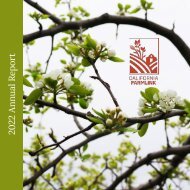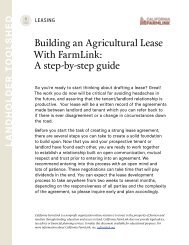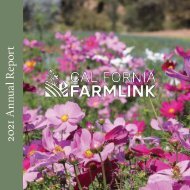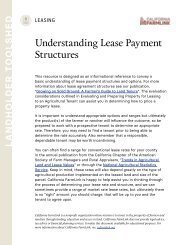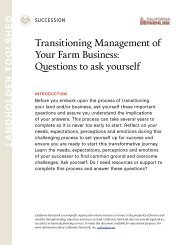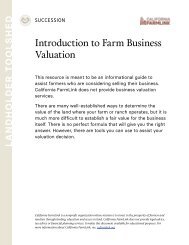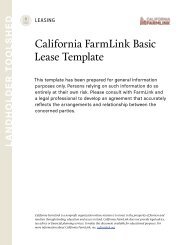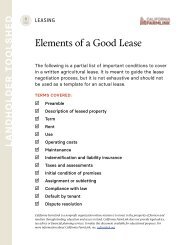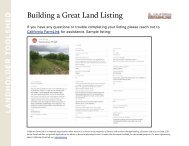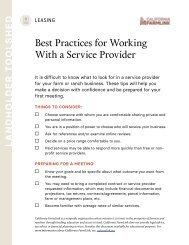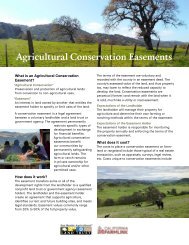Guide to Regenerative Grazing Leases: Opportunities for Resilience
California FarmLink and TomKat Ranch Educational Foundation teamed up to create this resource focused on land leases that support regenerative grazing practices. This guidebook aims to empower private, nonprofit, and public landholders, as well as easement-holders and grazing tenants.
California FarmLink and TomKat Ranch Educational Foundation teamed up to create this resource focused on land leases that support regenerative grazing practices. This guidebook aims to empower private, nonprofit, and public landholders, as well as easement-holders and grazing tenants.
You also want an ePaper? Increase the reach of your titles
YUMPU automatically turns print PDFs into web optimized ePapers that Google loves.
CHAPTER 2. <strong>Grazing</strong> <strong>Leases</strong> (Continued)<br />
ASSIGNMENT/SUBLEASING<br />
Language <strong>to</strong> allow <strong>for</strong> subleasing can be beneficial <strong>for</strong> both parties—especially<br />
<strong>to</strong> support smaller graziers who may not use a larger property in its entirety. It<br />
is important <strong>to</strong> state a requirement <strong>for</strong> landholder approval of any sublessee and<br />
sublease agreement <strong>to</strong> ensure a transparent relationship and understanding.<br />
INDEMNIFICATION/INSURANCE<br />
Balanced, dual indemnification is recommended <strong>to</strong> support an equitable and secure<br />
agreement <strong>for</strong> both parties. It is prudent <strong>to</strong> identify that any loss, disease, or<br />
predation of lives<strong>to</strong>ck, or damage caused by escaped lives<strong>to</strong>ck from the Property<br />
be the responsibility of the lessee. A lease agreement or grazing contract <strong>for</strong> fee<br />
may also stipulate that the lessee is not responsible <strong>for</strong> any damage by animals<br />
<strong>to</strong> the landholder’s perennial crops or landscaping. It is generally required that the<br />
landholder has property/homeowner’s insurance, and that the lessee has liability<br />
insurance; in this way, both parties should be sufficiently protected against natural<br />
disasters, injury, and damages. The lessee should name the landholder as additionally<br />
insured on their policy, provide verification of coverage <strong>to</strong> the landholder, and<br />
maintain the policy throughout the Term. The lessee may be required <strong>to</strong> maintain<br />
additional insurance relevant <strong>to</strong> their operation, including but not limited <strong>to</strong> lives<strong>to</strong>ck<br />
insurance, au<strong>to</strong>mobile insurance, and workers compensation insurance.<br />
COMMUNICATION AND DISPUTE RESOLUTION<br />
Open and frequent communication can improve the success and longevity of any<br />
lease. Because the need <strong>for</strong> adaptability is inherent <strong>to</strong> regenerative management,<br />
communication is especially important <strong>to</strong> regenerative grazing leases. In fact, the<br />
lessee-landholder relationship is being increasingly recognized <strong>for</strong> its critical role in<br />
advancing soil health (see this article from Civil Eats).<br />
Communication and Dispute Resolution clauses should be included in the main lease<br />
body. When an AMP is used in conjunction with a lease, the AMP should include its<br />
own communication ground rules relevant <strong>to</strong> the AMP, and consistent with the lease<br />
clause on communication.<br />
© Copyright 2022 Cali<strong>for</strong>nia FarmLink and TomKat Ranch Educational Foundation<br />
28



